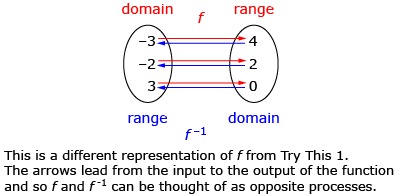Explore
In Try This 1 you saw that the two functions y = f(x) and x = g(y) “undid” each other. An input of −3 into function f gave an output of 4, whereas an input of 4 into function g gave an output of −3. Functions that “undo” each other, such as f and g, are called inverses. The function g(x) is often written as f −1(x).
You may have noticed that the domain and range of the function became the range and domain of the inverse, respectively. This will always be true of inverses.

Watch Function Notation—Explanation to see a graphical representation of the different notations used so far in this lesson.

Note that  If you want the reciprocal of f(x), it can be written
If you want the reciprocal of f(x), it can be written  In this lesson you are studying inverse functions, not reciprocals.
In this lesson you are studying inverse functions, not reciprocals.
As you saw in Try This 1, the inverse of a function can be found by switching the x- and y-coordinates. The original relation and its inverse were both functions in Try This 1. Do you think the inverse of a function will always be a function?
Try This 2
Open Inverse of a Function. This applet shows various functions and their inverses. Try looking at the different functions available in the applet to help you answer the following questions.

- Use the applet to determine when the inverse of a function is a function.
- Describe a rule that could be used on the original function to determine whether or not its inverse will be a function.
 Save your responses in your course folder.
Save your responses in your course folder.


